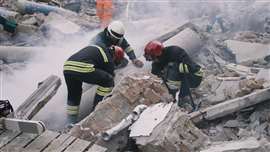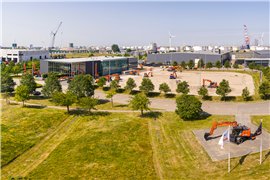Building better: The infrastructure resilience overhaul
11 October 2023
We live our lives inside buildings. Whether we call them home, work or places of education, we subconsciously rely on their stability every day. Yet our current attitude towards infrastructure ignores the biggest threat yet – climate change.
 Emergency workers amid the rubble of collapsed buildings. Photo: Frame Stock Footage - iStock - Shutterstock
Emergency workers amid the rubble of collapsed buildings. Photo: Frame Stock Footage - iStock - Shutterstock
Every year, disasters linked to natural and climate hazards strike, and our infrastructure suffers.
Flooding and Other Extremes
At the beginning of August 2023, Slovenia was hit by torrential rainfall causing flooding and landslides. Labelled the country’s ‘worst-ever natural disaster’, the extreme weather has caused hundreds of millions of euros of damage to homes and critical infrastructure.
Although the rain has now stopped, the risk of landslides resulting from unstable earth is prevalent and posing serious threats to communities and remaining buildings.
This is not the first severe weather event of the summer in Slovenia this year, with several storms downing thousands of trees in the Alpine nation and killing one person.
Following the destruction caused by climate-related incidents, the Slovenian government had to distribute funds and find humanitarian aid for those affected.
This corresponds with findings from Lloyd’s Register Foundation’s 2021 World Risk Poll powered by Gallup, which found that only 17.87% of Slovenian respondents felt that national government were well prepared to deal with a climate disaster.
Many countries find themselves unprepared when disaster strikes, and Slovenia’s example of being forced into reactivity as a result of natural disaster is not unique.
In May 2023, for example, the UK Health Security Agency deemed England’s built environment unfit to face extreme heatwaves, with the Committee on Climate Change finding it wholly unprepared to face the effects of global warming.
In the event of natural disasters such as critical heatwaves, England would face similar reactive decisions to Slovenia.
In disasters of such scale, the economic consequences are felt for years, with rebuilding requiring a huge amount of investment.
However, making changes to infrastructure plans today could minimise the impact of these extreme events in the future – both in terms of cost and the harm they inflict.
Fortifying the foundations: Building more resilient infrastructure
$94 trillion – this is the estimated amount of new funded infrastructure required to meet increasing global building needs by 2040 due to urbanisation and climate change. The task ahead is incredibly challenging, but complacency could lead to far graver consequences.
This is where initiatives like Resilience Rising come in. A partner of Lloyd’s Register Foundation, the organisation is a global platform for collective impact that strives to achieve systemic resilience and build momentum toward a safe, resilient, and sustainable future for all.
Resilience Rising achieves this through working closely with a broad constellation of partners, such as the International Coalition for Sustainable Infrastructure (ICSI), which mobilises the engineering community to address climate change and improve the resilience and sustainability of critical infrastructure. However, an urgent shift in attitude is needed to make this a reality.
Making the right decisions early on in an infrastructure plan can help stabilise our buildings, giving us confidence that foundations laid can absorb and recover from shocks and stresses caused by climate change and natural disasters.
Championing change in the built environment
The learnings from developing resilient infrastructure can also be applied at an organisational level. Part of the solution is appointing a board-level resilience champion.
This individual would be responsible for ensuring culture change and adoption of resilience strategies throughout an organisation.
Having a resilience champion who sits on the board of a company ensures leadership and that guidance from the top is filtered throughout the organisation, with resilience embedded into daily practices.
To build resilience into our buildings, we need to invest in resilient teams who have the tools to absorb and rebuild from internal shocks, too. Every company will face a crisis at some point – it’s inevitable.
That’s why taking a holistic approach to resilience throughout a company identifies weaknesses and vulnerabilities at different points. In turn, this establishes a clear line of communication and understanding of responsibilities in times of crisis.
Highlighting the importance of resilient infrastructure, The Engineering Leadership Group (ELG) launched its new manifesto calling for decisive and radical action from all infrastructure stakeholders.
Advocating for future buildings that leave no one behind, the manifesto focuses on new developments and retrofitting existing builds.
That’s why The ELG argues that to enable net zero projects, global funding investment needs to be unlocked, with a focus on resilience embedded at every level of the decision-making process.
International legislation and guidance are also needed to efficiently tackle the problem of insufficient infrastructure across continents. Acknowledgement of the urgency required in protecting and bettering buildings has been highlighted across the EU with the establishment of The European Programme for Critical Infrastructure Protection (EPCIP).
Aimed at improving the protection of critical infrastructure in Europe, a universal set of guidelines and regular meetings allow for a common approach to tackling infrastructure insufficiencies to be established.
A resilient future for all?
Climate change demands urgent action and we must face up to the stark reality we find ourselves facing. No part of the world is exempt, and we are all responsible for what happens next.
In many places across the world, the critical infrastructure that we rely on daily is past its original design life.
Properly funding these changes to more resilient infrastructures is paramount to any success and requires companies and charities to come together.
At Lloyd’s Register Foundation, we have already awarded 22 grants in the safety of critical infrastructure area. With our Foresight review of structural integrity and systems performance, we’ve highlighted the key safety challenges that exist in current infrastructure and identified how resources should be directed to address them.
These include:
- Materials and their degradation: Understanding the long-term performance of new materials.
- Measurement and sensing: Understanding the condition of an asset using data collection.
- Simulation and modelling: Understanding how assets will perform in their operating environments.
- Systems, complexity, and risk: Assuring that a system will maintain its function through system performance.
- Knowledge transfer: Transferring knowledge from industrial sectors to plug the skills gap.
Identifying architecture that needs retrofitting is part of the solution but building with resilience in mind, negates the need for retrofitting entirely.
Seeing homes and buildings reduced to rubble has become sadly too common. Why? Because instead of fixing the root cause of our infrastructure problems, we have accepted clean-ups as an unavoidable part of managing natural disasters. But it doesn’t have to be this way.
By becoming more resilient, we can get ahead of the curve and make sure no one is left behind in the fight for sustainable and structurally sound buildings.
|
About the author Jan Przydatek is director of technologies at Lloyd’s Register Foundation, a charity that helps to protect life and property and support education, engineering-related research and improving society’s understanding of risk. To find out more about Resilience Rising, visit: resiliencerisingglobal.org/ To find out more about Lloyd’s Register Foundation, go to: lrfoundation.org.uk/ |
CONNECT WITH THE TEAM








